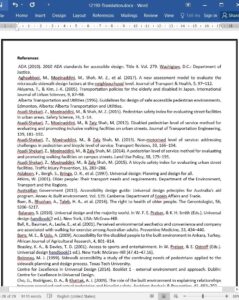Abstract
Equitable use (EU) is the first principle of universal design and promotes the usefulness and marketability of products for people with diverse abilities. Sidewalks, as the main circulation path for pedestrian transportation, can be designed and assessed based on this principle to improve their usability for all pedestrians. Currently, there is no clear definition of EU in the sidewalk design criteria; consequently, no design and assessment guidelines are based on this concept. This study aims to remedy this shortcoming in knowledge by defining and translating the theoretical and conceptual components of the characteristics of EU for sidewalks. This study also attempts to identify the contributions of sidewalk design factors in the main dimensions of EU applied to sidewalks. To achieve these objectives, we conduct an extensive literature review of available universal design guidelines and handbooks as well as scientific articles regarding the implementation of EU in outdoor environments and sidewalks. The results of this review contribute to the development of conceptual models to define EU in sidewalk design. A questionnaire was administered to collect data to test the fitness of these conceptual models. Fitness tests are conducted with structural equation modelling (SEM). The EU translation can be useful for designing and assessing sidewalks to ensure that sidewalks serve people with various abilities on an equal basis.
1. Introduction
Walking is the most common form of physical activity (Kelly, Schootman, Baker, et al., 2007; Saelens, Sallis, & Frank, 2003), and sidewalks are the main channels upon which walking can be undertaken (Hooker and Architecture, 2007). Since sidewalk users are diverse in terms of age, gender, and physical condition, it is necessary to design sidewalks that serve the broadest range of users (Aghaabbasi, Moeinaddini, Shah, et al., 2017; Asadi-Shekari, Moeinaddini, & Zaly Shah, 2013). It is also vital to constantly assess existing sidewalks to ensure that sidewalks accommodate all people on an equal basis regardless of their sociodemographic characteristics and physical, sensory, and cognitive conditions (Aghaabbasi et al., 2017; Asadi-Shekari et al., 2013; Kadali & Vedagiri, 2016).
5. Discussion and conclusion
The aim of this research was to translate the general concept of equitable use into sidewalk design criteria and to identify the main dimensions of EU for sidewalks. EU is the first principle of UD and involves serving people regardless of their backgrounds and abilities. UD principles are not well implemented in sidewalk design, and existing sidewalks do not serve people on an equal basis. Thus, applying new concepts such as EU and developing tools to assess sidewalks based on this concept can assist urban and transportation planners in finding shortcomings related to sidewalks and taking action to improve them. The translation of EU into sidewalk design criteria will contribute to finding a mechanism to assess existing sidewalk conditions and quantifying the level of improvement required in a practical and systematic manner.











